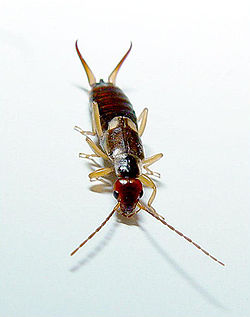| Forficula | |
|---|---|
 | |
| Forficula auricularia | |
| Scientific classification | |
| Kingdom: | Animalia |
| Phylum: | Arthropoda |
| Class: | Insecta |
| Order: | Dermaptera |
| Family: | Forficulidae |
| Subfamily: | Forficulinae |
| Genus: | Forficula Linnaeus, 1758 |
| Species | |
See text | |
Forficula is a genus of earwigs in the family Forficulidae; it was first described in 1758 by Swedish biologist Carl Linnaeus in the 10th edition of Systema Naturae. The name Forficula is Latin for earwig, formerly small pinchers. [1] The genus spans all continents except Antarctica and is native to Afro-Eurasia, primarily Europe. [1] The best known species is Forficula auricularia and is a common household pest.

